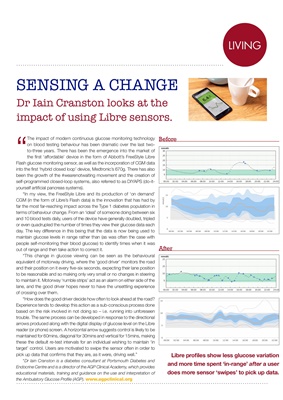
KITLIVING
SENSING A CHANGE
Dr Iain Cranston looks at the behaviour
change impact of using sensors.
"The impact of modern continuous glucose monitoring technology on
testing behaviour has been dramatic over the last two-to-three years.
There has been the emergence into the market of the first 'affordable'
device in the form of Abbott's FreeStyle Libre Flash glucose monitoring
sensor, as well as the incorporation of CGM data into the first 'hybrid
closed loop' device, Medtronic's 670g. There has also been the growth
of the #wearenotwaiting movement and the creation of self-programmed
closed-loop systems, also referred to as DIYAPS (do-it-yourself artificial
pancreas systems).
"In my view, the FreeStyle Libre and its production of 'on demand'
CGM (in the form of Libre's Flash data) is the innovation that has had by
far the most far-reaching impact across the Type 1 diabetes population in
terms of behaviour change. From an 'ideal' of someone doing between six
and 10 blood tests daily, users of the device have generally doubled, tripled
or even quadrupled the number of times they view their glucose data each
day. The key difference in this being that the data is now being used to
maintain glucose levels in range rather than (as was often the case with
people self-monitoring their blood glucose) to identify times when it was
out of range and then take action to correct it.
"This change in glucose viewing can be seen as the behavioural
equivalent of motorway driving, where the 'good driver' monitors the road
and their position on it every five-six seconds, expecting their lane position
to be reasonable and so making only very small or no changes in steering
to maintain it. Motorway 'rumble strips' act as an alarm on either side of the
lane, and the good driver hopes never to have the unsettling experience
of crossing over them.
"How does the good driver decide how often to look ahead at the road?
Experience tends to develop this action as a sub-conscious process done
based on the risk involved in not doing so - i.e. running into unforeseen
trouble. The same process can be developed in response to the directional
arrows produced along with the digital display of glucose level on the Libre
reader (or phone) screen. A horizontal arrow suggests control is likely to be
maintained for 60mins, diagonal for 30mins and vertical for 15mins, making
these the default re-test intervals for an individual wishing to maintain 'in
target' control. Users are motivated to swipe the sensor often in order to
pick up data that confirms that they are, as it were, driving well."
*Dr Iain Cranston is a diabetes consultant at Portsmouth Diabetes and
Endocrine Centre and is a director of the AGP Clinical Academy, which provides
educational materials, training and guidance on the use and interpretation of
the Ambulatory Glucose Profile (AGP). www.agpclinical.org
Before
After Data shows a wider range of glucose
variation and lower time-in-range
before sensor use compared to after.